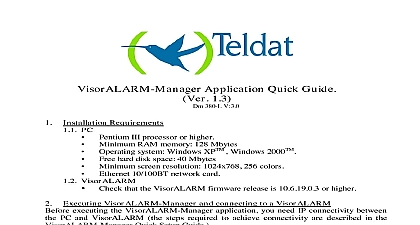Silent Knight Telsec VisorALARM High Availability Receivers

File Preview
Click below to download for free
Click below to download for free
File Data
| Name | silent-knight-telsec-visoralarm-high-availability-receivers-2768501934.pdf |
|---|---|
| Type | |
| Size | 858.86 KB |
| Downloads |
Text Preview
Alarm Service High Availability IP Redundancy DOCUMENT version VisorALARM mIP VisorALARM architecture for Availability November 2007 version Draft 1 2 SYSTEM TOPOLOGY AND OPERATION 3 THE TRAFFIC PATTERN CHARTS 4 IP traffic flows between the IPDACT 2 2UD and the VisorALARM 4 VisorALARM clock synchronization 5 VisorALARM query for Data Base update 5 VisorALARM Data Base synchronization 5 1 Introduction Alarm Monitoring Service as any other mission critical service has tight restrictions its availability As any mission critical service any loss of performance or service can derive into a high loss of revenue customer dissatisfaction and what it is it can lead to loss of human lives Recovery Plans spans over all service elements coordinating them together in in of the highest availability There are diverse ways to implement Disaster Recovery for Alarm Monitoring Services However all of them have something in common must be supported over the most robust communications paths important challenge becomes a big concern in IP based alarm systems hence the for intelligent platforms that can automatically react to network service breakdowns keep the Alarm Service running without losing any performance Teldat IP Alarm system adds the IP Communication path to the traditional Alarm The high availability improvement over the telephone network elements this goal by delivering line redundancy to the Fire Panel side as well as to the Monitoring Station CMS The line redundancy in the CMS can be combined equipment redundancy the VisorALARM are grouped in clusters1 document describes Teldat IP line redundancy in the CMS network The backup is detailed and all the system elements are listed In the next section the Teldat and VisorALARM text configuration parameters required for the IP are explained Finally a detailed explanation on the Teldat IP Alarm System is given VisorALARM clusters are not considered in this document 2 System topology and operation 1 IP network diagram for CMS High Availability operation IPDACT 2 2UD only communicates with the Main VisorALARM receiver over the CMS line The main VisorALARM hence deals with the three IP traffic flows alarm transmission and supervision delivered by all IPDACT 2 2UD on The main Communication path of this IP traffic in the CMS network is depicted in in the above Figure in Emergency a main link failure the IPDACT 2 2UD switches the transmission over the backup line to the backup VisorALARM The backup VisorALARM is taking the roll of a VisorALARM serving all IPDACT 2 2UD on field just as if it was the main one backup Communication path is colored red in Figure 1 On the other hand the 3 keeps supervising the link to the main VisorALARM receiver so it can back to Normal Operation as soon as the main link is recovered backup switching as well as the main link recovery process is automated so no user is required Data Base synchronization each VisorALARM keeps its own Data Base with the IPDACT 2 2UD accounts on the main VisorALARM and the backup Data Bases must be synchronized at all so the backup VisorALARM can keep the update of new IPDACT 2 2UD and serve them in emergency conditions Data Base update process is sensitive to the internal time clocks of each receiver In fact both VisorALARM units must synchronize their clocks a Network Time Protocol Server NTP server This clock server can be of private as shown in Figure 1 or can be a public server located in the Internet Data Base synchronization is carried out periodically and involves two additional flows between both receivers Polling The backup VisorALARM polls the main one periodically for Data Base Update If there has been any change between the two Data Bases they are The traffic pattern charts CMS network depicted in Figure 1 has been simplified for a better understanding of system backup performance In real scenarios the CMS network can be of diverse and will of course include Firewalls to increase the security defined in the previous section there are different communication flows that must be along the IP network for the backup system to work properly IP traffic flows between the IPDACT 2 2UD and the VisorALARM the communication flows between the IPDACT 2 2UD and the currently active either the main or the backup one is of type UDP and they have the pattern 4 of units involved Port at 1 IPDACT 2 2UD VisorALARM traffic pattern default Destination Port value can be modified in the IPDACT 2 2UD and configuration VisorALARM clock synchronization the main and the backup VisorALARM synchronize their internal clocks with an IP server in compliance with the Network Time Protocol Standard type UDP of units involved NTP Port at 2 VisorALARM NTP Svr clock synchronization VisorALARM query for Data Base update of units involved VisorALARM VisorALARM Port at 3 VisorALARM queries for the DDBB update VisorALARM Data Base synchronization of units involved VisorALARM VisorALARM Port at 3 VisorALARM DDBB synchronization The Dst Port value shown in the Chart corresponds to the Destination Port Although the IPDACT fixes the Source Port the same value this one is usually changed to a random value in the IPDACT Internet access router NAPT translation 5


